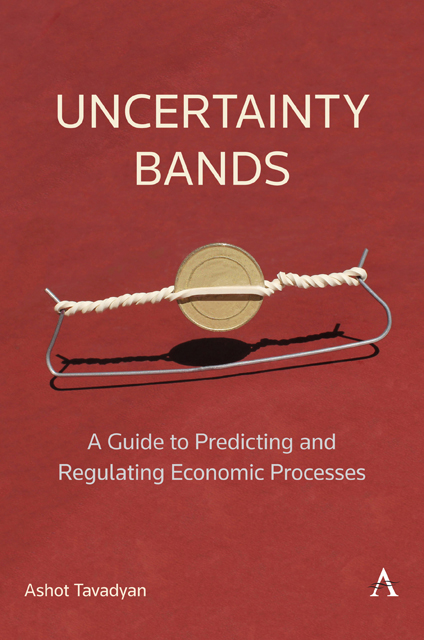Book contents
- Frontmatter
- Contents
- Preface
- Introduction: The Philosophy of Economic Forecasting
- 1 Interval Links in Economy and the Capabilities of Quantitative Thinking
- 2 The Possibilities for Forecasting Economic Indicators
- 3 The Principle of the Minimal Uncertainty Interval
- 4 The Intervals of Key Economic Indicators
- 5 Key Principles of Economic Regulation
- Conclusion
- Appendix: The Uncertainty Relations of Economic Indicators
- Acknowledgments
- Index
Appendix: The Uncertainty Relations of Economic Indicators
Published online by Cambridge University Press: 09 December 2022
- Frontmatter
- Contents
- Preface
- Introduction: The Philosophy of Economic Forecasting
- 1 Interval Links in Economy and the Capabilities of Quantitative Thinking
- 2 The Possibilities for Forecasting Economic Indicators
- 3 The Principle of the Minimal Uncertainty Interval
- 4 The Intervals of Key Economic Indicators
- 5 Key Principles of Economic Regulation
- Conclusion
- Appendix: The Uncertainty Relations of Economic Indicators
- Acknowledgments
- Index
Summary
The precise definition of economic indicators is impossible in any model, even if the model represents the economy in an extremely simplified form. It is only possible to formulate their ratio in general terms.
Illustrative examples of models are used herein since the complexity of the model is not critical for describing generalized functional interdependencies between indicators.
Below is an example of a simplified quantitative economic model:
where gj is the share of income in the price of the product j, ?ij is the expenses of the i-th resource in the unit production of the j-th product, Ri is the volume of the i-th resource and qj is the volume of product j.
The dual problem of the considered model is formulated below:
where ui is the optimal valuation of the i-th resource.
From the duality principle the optimal values satisfy the following conditions:
In the primal problem, the volumes of resources Ri, the share of income gj, the objective function of the direct problem and technological rates of resource consumption are known. Resources ui and volume of output qj are unknown and to be determined. It can be observed from the obtained ratio that if ui and qj are known, then the values of Ri and gj can be determined. Therefore, for any given set of variables, the optimal values of others can be obtained.
Thus, if a model contains price variables gj and ui while it is necessary to determine quantitative variables qj and Ri, then separately for both quantitative and price variables m + n linear equations with m + n unknowns can be obtained. Provided that the coefficients of the unknowns are positive, the rank of the matrix composed of the coefficients of the unknowns will be equal to m + n; in so doing, the quantitative variables will be found. Under the same condition, if quantitative variables are given, then price variables will be found.
Likewise, in any optimization model, point estimates of one group of quantitative and price variables can be found if only the other group is assigned a value. To determine some variables, the values of other variables must be taken for granted in advance.
- Type
- Chapter
- Information
- Uncertainty BandsA Guide to Predicting and Regulating Economic Processes, pp. 83 - 86Publisher: Anthem PressPrint publication year: 2022



